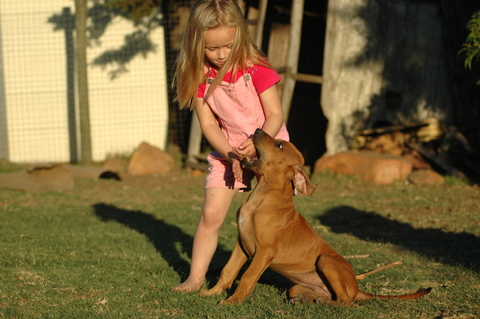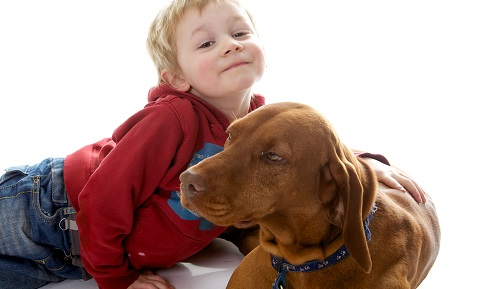What to Do When Dog Keeps Hurting Baby
What is the touch of canine aggression toward a kid?

How can I prevent my dog from being aggressive toward children?
The all-time mode to accost aggression toward children is to prevent it. During their socialization period (6 to 14 weeks of age), puppies are highly curious and impressionable. Making sure that puppies have numerous positive encounters with children of all ages during this menstruation tin can help them cultivate a positive attitude towards children after on in life. Desensitizing them to being touched around the face and caput and even tugged on gently will set them for the means that they are touched by children. Later on 14 weeks of age, puppies become considerably more humble of their surround and react more appallingly to threatening stimuli. It is important to avert negative experiences during this time as much as possible. Do not use punishment techniques to make sure that dogs practice not go fearful. Striking a dog tin specifically cause a fear of beingness touched and may put children at a greater risk. Keep in listen that interactions with children outside of the abode are not necessarily protective against fear and anxiety when afterwards children occupy the dwelling house with the dog.
When choosing a dog for a family unit with children, take several factors into account. Consider breed and family history every bit well equally the dog'southward history of behavior around children. Try to spend fourth dimension with the dog before adopting the domestic dog into a house with children. Look for signs of fright, apprehension, or avoidance in the dog or in the children.
- Make sure to have your dog spayed or neutered.
- Avoid interacting with your dog in whatever way that you would not desire him/her to collaborate with a child (wrestling, rough-housing).
- If your dog shows any signs of assailment, seek professional help immediately earlier these habits become ingrained.

How should dogs exist introduced to children?
- Never leave young children and infants lonely with any dog.
- Cage dogs when around children if they have shown any aggression in the past.
- An adult should closely supervise all introductions between children and dogs.
- Use of a head-halter and leash tin can exist helpful for maintaining command of the dog and in preventing unruly, exuberant or aggressive behavior.
- Do not use punishment for bad behavior or disobedience every bit this can greatly increase a domestic dog's fear and make them more than aggressive.
- If the dog finds the state of affairs stressful or shows unwanted responses they should calmly and immediately be removed from the situation.
- Make sure you take skillful verbal control of your dog (sit, down, come, drop it).
- Take children requite known commands to the canis familiaris if the encounter is going well. Ideally, these commands take been taught by positive reinforcement grooming which allows the dog to generalize and comply with commands given by a diversity of adults and children.
- Keep aggressive dogs safely separated from children.
- See Children and Pets, Crate Training – Guide – How to Crate Train, Learn to Earn – Predictable Rewards, Educational activity Calm – Settle and Relaxation Preparation, Training Products – Head Halter Training, and Muzzle Grooming.
What can be done if my dog is already showing some assailment toward children?
Keeping children rubber throughout this process is the primary business organization. Once a dog has shown any signs of fright or assailment effectually children, you cannot assume that he/she will be safe to leave with children. Even if the canis familiaris has had several positive encounters with children, an adult should closely monitor all interactions. Sometimes an individual dog will never be safe around children.
Desensitization
Desensitization should take identify in a slow, stride-wise manner. The child'southward safety must exist preserved during this process. The goal is to expose the dog to the kid in a comfortable setting and at the distance where the dog is showing no signs of fear. Watch for subtle signs of canine fear or stress: yawning, lip licking, trembling, crouching, ears down, tail tucked. Signs of aggression and potential for escalation to a bite include barking, hair standing on end, snarling, growling, or snapping. Requite the dog basic commands (east.g., sit, downwardly, milk shake) and reward these tasks with favored treats. Over several successive sessions, the domestic dog might be able to motion closer to the kid. If the canis familiaris becomes agitated, fearful, tense, disobedient, or refuses treats, so back up to a distance where the dog is more comfortable. Once the domestic dog is accepted to the presence of the child/children, the children can practise giving the dog exact commands besides. This procedure tin be greatly facilitated by didactics relax and settle commands to help the dog remain at-home. A gentle leader caput halter can too be an invaluable tool during this process.
Classical conditioning
Classical conditioning is another first-class tool for helping dogs become more comfy around children. The goal is to give the domestic dog's favorite treats whenever children come up near. In this way, the dog volition learn to acquaintance children with getting tasty treats. When the dog is well acclimated, children tin can offer treats to the dogs whenever they arroyo. Remember to keep the kid's safety in heed. Start by exposing the dog to a child that is being carried by an adult. But allow the child to collaborate directly with the dog once the canis familiaris is showing no signs of fear or aggression and is looking excited nearly the meet.
How can children be taught to safely collaborate with dogs?
Children should be taught proper conduct around dogs starting as early equally 18 months of age. Children should be positively rewarded for good interaction and immediately stopped if they are acting inappropriately. All interactions between children and unfamiliar, fearful or aggressive dogs should be monitored.
What should children exist taught NOT to do?
- Do not play with dogs that are jumping up or interim too unruly.
- Practice not disturb a dog that is eating, sleeping or caring for puppies.
- Do not bear on a dog you practice not know without asking permission.
- Do not touch a dog you practice not know when there are no adults nearby.
- Practice not touch any dog that is showing signs of fear or aggression.
- Do not pursue a domestic dog that is moving abroad (moves away, crouches, growls).
- No teasing, punishing or crude play with any dogs.
- Do non bear on a dog you do not know on the head.
- Avert waving hands most a dog's head.
- Avoid yelling, squealing or startling a canis familiaris.
What should children do around unfamiliar dogs?
- Enquire permission to touch unfamiliar dogs.
- Requite the canis familiaris a chance to approach, see and sniff them before touching.
- Let the dog come to them instead of reaching for the dog.
- Pet the dog only on the back and sides.
- Speak to them in a at-home voice.
- Dorsum away if the domestic dog looks nervous, moves away, freezes, snarls, growls or attempts to bite.
What should children exercise around familiar dogs?
- Give simple commands and praise the dog for compliance.
- Requite treats (equally permitted) when approaching the canis familiaris.
- Command the dog to settle and relax in order to keep them calm (these are skillful commands to teach any dogs who live with children or are highly energetic).
What should children practise when confronted by an aggressive domestic dog?
- If an aggressive domestic dog approaches, stand very still and stay quiet "like a tree."
- If knocked over, roll in a ball and lie even so, "like a rock."
- Immediately tell an developed about what happened.
What is the takehome message?
Dog bites are serious: dog bites to children are especially disturbing. We expect our dogs to act similar Lassie and our children to enjoy a carefree relationship with dogs. The CDC reports that injury rates for bites were the highest among children age five to nine. Show as well suggests boys are more likely to exist bitten than girls. Children under the age of 4 were most probable to sustain bites to the face up or neck. More than children are bitten by a familiar canis familiaris than a strange domestic dog. We must do a better job of preparing our children how to act around dogs. We must as well train and socialize our dogs to await the unpredictable things children do.
What to Do When Dog Keeps Hurting Baby
Source: https://vcahospitals.com/know-your-pet/dog-behavior-problems-aggression-children

0 Response to "What to Do When Dog Keeps Hurting Baby"
Post a Comment